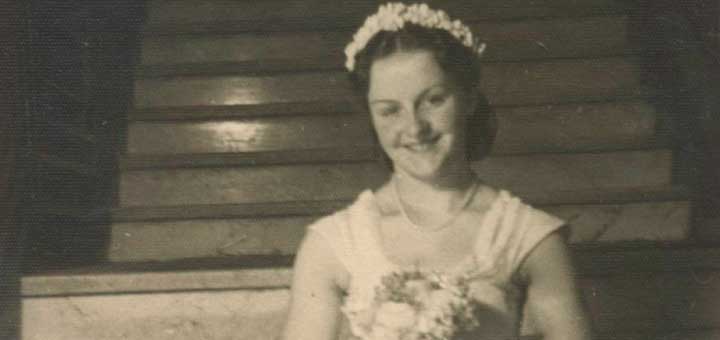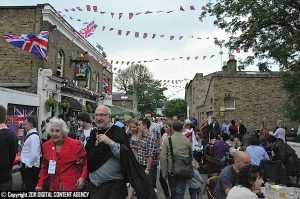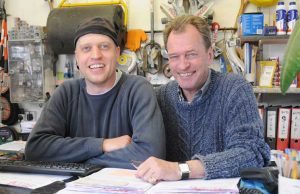Local historian Oliver Cyriax interviews a woman with altitude: an airship-pioneer who braved the heights in the 1930s.
A Profile in Courage by local historian Oliver Cyriax.
Dateline: Ravenscourt Park 1936
“Of course our flock scattered as the Graf came in,” says Vera Pith-Scottley. “It took three hours to find Maisie, she always was my favorite.”
Still sprightly at 94, Vera explains “The men rigged a temporary mast where the café is now.”
It was 14 March 1936 when the Graf Zeppelin came calling on its record-breaking round-the-world trip.
Ravenscourt Park, where Vera’s family had grazing rights, was never on the planned itinerary. The airship’s captain Dr Eckener radioed ahead only hours before – trouble with the port diesel.
“At least that’s what he told the newspapers, “ Vera says. But she has the inside story. Vera became the Zeppelin Line’s first air-stewardess, flying out from Paddenswick Road over the Azores to the Graf Zeppelin’s celebrated ticker-tape welcome in New York. “It was Von Lehmann who told me”, she says. “They’d run out of sheet-music! It was an emergency all right. He said if he heard the Horst Wessel Song one more time he’d shoot the pianist.”
The Graf could accommodate thirty-two passengers (and an aluminum baby grand) with the comforts of an ocean-liner. “I couldn’t believe it,” says Vera. “Sleeper cabins with foldaway basins! A big fat promenade, the chef with his white hat, French wines and a cocktail bar!” Vera was just 16. “You can’t imagine the excitement,” she says. “Brackenbury really was a village then. Suddenly we had International Pressmen everywhere.”
It was a far cry from Vera’s simple Irish roots. Her father, a bucolic farmer from Tipperary, developed his fascination with chips at a local country fair. But the high cost deterred the local market. “We landed at Liverpool and worked our way south,” says Vera. “Pa kept the sheep on Shepherd’s Bush… it was just luck my being in Ravenscourt on the day. Pa had opened a chippie in Ashchurch Park Villas – right across the road from the Sulgrave Boy’s Club.”
It took a land-crew of 200 to moor an airship the Graf Zeppelin’s size. The begoggled Von Lehmann parachuted ahead from the Graf’s gondola – to help organize the makeshift ground-staff. He landed by the cricket nets where Vera’s dad was soon on hand. “Pa cleared those lads out of the Sulgrave PDQ”, she says, “and a local constable commandeered the midday riffraff from the Angelsea.” She muses, “The Graf was a fantastic sight… a ship of dreams… and hats… elegant ladies waving from the viewing-deck… shimmering. Quite magical.”
Maisie went to ground in the Hartswood Road allotments. Vera coaxed the lamb out (it was an emotional reunion). Von Lehmann called round on her family that evening to apologise personally. “This was my chance,” says Vera, “Every pound counts on
an airship.” I can still see what she means. Vera is one of those people who become shorter when they get down from a chair to stand up. “My family – well, really we’re a race of tiny people,” says this pint-sized Cardross Street resident. “The Graf’s steward had jumped ship at Ravenscourt, he took up in the brothel behind the farriers in Chiswick High – you know, the one where they accepted payment in fish, it was always busy.” And? “Lehmann swore the job was mine – provided I dressed as a boy. Dr Eckener was livid when he found out.”
Vera served almost a year on the Zeppelin Line’s Friedrickshaven – Brazil run. “You can’t imagine”, she says. “It was fine-dining. I’ve waltzed over the Pacific, in the stars – I’ve seen snow on the Oberoi mountains at first light, our tail-gear practically clipped the peak – I’ve drifted above the last of the square-riggers, sipping an iced Manhattan.”
Vera lived a charmed life indeed. She was posted to the Zeppelin’s Line’s flagship, the Hindenburg, part of the crack-team on the ill-fated voyage that ended in fiery cataclysm on 5 May 1937 (Lakehurst USA). But the route there was triangular via a stop-off in Brazil. Vera explains: “I wept when they put me off at Rio. I broke my leg. When coming into land even a few ounces makes all the difference”.
Vera’s job was to scamper back and forth down the Hindenburg’s narrow central corridor. “I was in elevation-control” she says. “I trimmed the Hindy’s, bows up, and her nose down, in the final moments of each descent. Believe me, I had to shift it! “Back”,
Lehmann would bark, “aft a bit more” – and then next it’s all “no, no, belay that – down this end, schnell! schnell!” Orders were transmitted down voice tubes”.
Vera turns the pages of her fading black-and-white album, pointing at the technical drawings. My research confirms these Monsters of the Sky were nearly three hundred yards long. So when the Graf Zeppelin’s nose swung from the Ravenscourt café, her tail was halfway down the Uxbridge Road. Vera says: “I came a cropper at Sugar Loaf Mountain for sure. Flat on my face. It was the up-currents, the Hindy was in danger”. She adds morosely of her friends, “In the end, they burned to a crisp.”
The Zeppelin Company folded after the Lakehurst conflagration and Vera was left high and dry in Brazil. But not for long, I suspect, with this resourceful woman. “I made my way to the favellas. I did quite well actually,” she says, “our thinking was ahead of theirs. It was managerial. But after the sixties I hankered for home”. Vera won’t be drawn on her Rio years. Back home, she married a Chiswick divorce lawyer: for the first time a sense of tedium fills our meeting. They separated. The interview is over. “I’ll always have my memories”, Vera sighs.
As I make my farewells, I notice a dented cocktailshaker has pride of place on her parlor’s mantelpiece. “Yes”, Vera says, “I call that my life-saver. It’s what I tripped on”.
This has been a fascinating hour. As Vera says, “so much life, so long ago, when my ship came sailing in…”
Copyright © Oliver Cyriax.
No airships were harmed in researching this article.



